History of Bharatpur/Chapter III
By Jwala Sahai
Printed by Lall Singh, in Moon Press, Agra, 1912
| The full text of this book has been converted into Wiki format by Laxman Burdak लक्ष्मण बुरड़क |
Chapter III
The modern Period

The battle of Laswari
Page 33
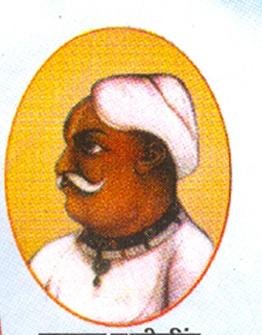
With exception of the Maharana of Dholpur already mentioned, Maharaja Ranjit Singh of Bharatpur was the first of all the Rajputana princes, who hailed the advent of the British rule with sincere delight. No sooner was he apprised of the success of General Lake at Delhi on the 11 th September 1803 than he sent his Vakils, Jani Daya Shankar and Foujdar Sheo Singh who met the General at Ballabhgarh on his way from Delhi to Agra on the 25th and treaty of amity and alliance was concluded on the 29th September 1803.
Pursuant to this covenant, the Maharaja sent a body of five thousand cavalry to co-operate with the British army at Agra. The contingent joined it on the 4th October 1803, the day of General Lake's arrival at Agra, rendered valuable services in the capture of Agra, on the 18th October and in the battle of Laswari on the 1st November 1803 and was employed till the conclusion of the campaign.
After the glorious victory at Laswari, General Lake encamped some days at Paharsar in Bharatpur and was so much pleased with this early proof of Ranjit Singh's loyalty that he at once made a grant of the parganas of Kishangarh, Kathumar, Rewari, Gokul and Sahar. In regard to the other chiefs he wrote on the 14th November to Marquis of Wellesley, " I every day experience more fully the advantages gained by the victory on the 1st, the consequences attending it are beyond all calculation." "In short the whole of these people will now come in, as they find they have neither hopes of rallying point nor fear from their neighbour."
Page 34
Treaties were concluded between the Honourable Company and the following States also :-
The first visit of Ranjit Singh to General Lake at Kanawar near Bayana on the 10th December is thus described by Major Thorn in his Memoir of the War in India :-
- " His Excellency and staff went a few miles to meet him on elephants, escorted by a troop of each of the dragoon regiments.Ranjit Singh is the son of celebrated Suraj Mal, Chief of the still powerful nation of the Jats. The Raja who appeared to be an elderly little man was dressed very plain and after giving and receiving some trifling presents he returned to his capital."
Shelter to Holkar troops at Deeg
The alliance with the British Government which fully compensated him for the losses of his early career, was in every respect satisfactory to Ranjit Singh, still when the war broke out between the Company's Government and Jaswant Rao Hulkar and the troops of the latter took refuge under the walls of Dig, he not only failed to drive them but also protected them against the British troops.
The causes which induced him to adopt such a course, besides the general principle of Sharna or Sheltering a refugee, held sacred in all nations, and particularly among the hindus, are thus enumerated by Mill and Wilson in their history of British India., Vol. 6, page 426.
- 1. Violence of the British Residents at Mathura in deciding certain cases concerning the traffic in salt.
Page 35
- 2. Alarm caused by the reports that the British Government would establish English Courts of Justice in his territories.
- 3. His horror at the cow-killing propensity of the English.
General Lake invested Bharatpur
Whatever may be the cause, his protecting the enemy contrary to the terms of the treaty was an act of overt hostility. A British army invaded and captured Dig on the 23rd December 1804. General Lake invested Bharatpur also on the 7th January 1805, but the Maharaja seeing that fall of the fortress would be a certain prelude to his own overthrow, resolved to defend it with all the resources at his disposal and repulsed four successive assaults made on the 9th and 21st January and 20th and 21st February 1805 subjecting the British army to a loss in killed and wounded of 3203 officers and men.
Most of the English guns became unserviceable from incessant firing, the artillery stores and provisions were exhausted and the sick and wounded were very numerous. The army thus being no longer in a condition to renew hostile operations, the ordnance and troops were withdrawn, General Lake occupied a position to the north-east of Bharatpur, commanding the roads to Agra, Mathura and Dig and ordered supplies of all kinds from different parts and battering guns and ammunition from Fatehgarh and Aligarh.
It is much to the credit of the Maharaja's prudence and sagacity that in spite of his success in the defence, he sued for peace and sent his son Kunwar Randhir Singh with keys of the fort to General Lake, whose elevation to peerage at the same time was taken advantage of, by offering congratulations.
Page 36
The peace was readily granted and terms were embodied in the treaty of the 17th April 1805 under which friendship was reestablished, Ranjit Singh on the condition of paying Rs. 20,00,000 (of which 7,00,000 were subsequently remitted) as indemnity, was confirmed in his old possessions, losing the territory granted by Lord Lake in 1803, In part payment of Rs, 13,00,000, a debt of Karauli, amounting to about Rs. 2,00,000 due to Bharatpur was transferred to British Government, as that state was semi-dependent on and indebted to Bharatpur.
Col. Malleson in his Native States of India eulogizes the event in the following terms :-
- " But though the Raja of Bharatpur lost by the line he had taken both money and territory, he gained in prestige and credit. His capital was the only fortress in India from whose walls British troops had been repulsed, and this fact alone exalted him in the opinion of princes and people of India."
Treaties of 1803-4,5
Treaties of 1803-4,5 - The terms of the treaties of 1803-4-5 plainly show that Bharatpur was held by the Supreme Government in higher esteem than the other States.
- 1. The declaration that, " the sincerity of this engagement is attested on the Holy bible," was graciously made in the Bharatpur treaty of 29th September 1803 and in no other.
- 2. In article 5th of their treaties, the other states agreed to refer their disputes and misunderstandings with their neighboring chiefs to the British Government and to abide by its decisions, but no such condition exists in the first treaty of Bharatpur, and the state was considered competent to deal with its neighbors in a proper manner.
Page 37
- 3 The stipulation in article 4th of the first treaty of Bharatpur is that the territories of one party being attacked by an enemy will be defended by the other with its forces; unlike the other states, Bharatpur is required neither to pay the charges of the British army when employed to assist it in its defence, nor to act in subordinate co-operation when its troops are employed in defence of the British dominions.
- 4. These conditions were not imposed even in articles 6 and 7 of the second treaty of 7th April 1805, so that article 4 of the first treaty virtually remains unchanged in this respect.
- 5. In article 4th of the second treaty, Bharatpur like other States has engaged not to admit any European, without the sanction of the Honourable Company's Government, but on the other hand the Government also has agreed, "not to give admission to any of the Maharaja's relations or servants without his consent," which was not done generally in treaties of other states,
Maharaja Randhir Singh
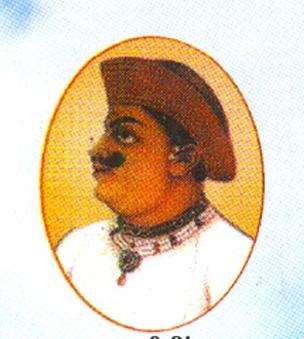
Maharaja Randhir Singh, who succeeded his father in the winter of 1805, was an able prince and remained loyal and faithful to the British Government.
It was during his reign that Lord Cornwallis and Sir George Barlow, successors to Marquis of Vellesley, resolved to abandon the system of subsidiary alliance with Native States as useless burden and actually abrogated the treaties with Jaipur and Jodhpur for which they found certain reasons.
Sir John Malcolm says :-" Sir George Barlow was equally anxious to dissolve the defensive alliance which we had contracted with the minor states of Bharatpur and Machehri, as he was that with Jaipur. But as these Rajas had given no pretext for this dissolution without their consent, he
Page 38
directed negotiation to be opened with them for the purpose and authorized Lord Lake to make a considerable cession of territory as,a means of prevailing upon them to relinquish their rights to our protection" "Lord Lake, however, was induced by a variety of urgent considerations, to deter offering any proposition of such a nature to these Rajas and he stated in the most forcible manner his fears that the very rumour of such a project being in the contemplation of the British Government would again involve in anarchy and confusion countries which had been settled at much expense of blood and treasure. The Governor General declared that although he was quite resolved upon the adoption of this measure, he did not desire to have it precipitated. Subsequent communications occasioned him to delay its execution, fortunately for the public interest the question was not again agitated and the Rajas of Bharatpur and Machehri with other chiefs settled in their vicinity continued in the faithful fulfillment of their engagements, to form an essential part of the strength which we derived from the maintenance of the territories to the west of the Jamna."
The Pindari War And the Treaties of 1817-18
The introduction by Lord Cornwallis of the non-intervention system, left the Rajasthan States a prey to the raids of Sendhia, Hulkar, Amir Khan and Pindaris. Truly says Col. Tod "what misery would not these states have been spared, had those engagements executed through the noble Lake, been maintained; for, the fifteen years which intervened between the two periods, produced more mischief to Rajwara than the preceding half century and a half century more Will not repair it." All Rajput States from greatest to the smallest were severely oppressed and reduced to extremities.
Page 39
Sir Charles Metcalfe, the Resident at Delhi, on being seriously consulted by Lord Moira the Governor General, declared his candid opinion by dividing the powers beyond British India into three classes and suggesting a treatment proper for each.
1. The Marhata States with armies and ambition desired to overthrow the British rule: but they were in treaty with the Government, they must be required to co-operate against the Pindaris and treated as enemies on failing to do so.
2. The Pindaris, men of all castes and religions combined for plunder with all cruel and torturous means and less tangible from having no state, were more dangerous and greater enemies of mankind and regular governments. Gaining proportions, beyond control and not content with devastating the native states, they extended depredation to British territories also. Amir Khan was a chief Pindari as well as Hulker's servant: he did not plunder a village or torture its inhabitants, but moved out with an organised army and struck boldly at principalities. He was a terror to the Rajput States; weak, helpless, distracted and mis-governed as they were, he found among them constant occupation for his predatory cohorts. It was necessary to annihilate Pindaris; and in order to enable Amir Khan to quit his lawless career, it was thought wise to guarantee in perpetuity the territory he held from Hulkar.
3. The petty Rajput States, Udaipur, Jaipur, Jodhpur and others, subjected to the oppression by the Marahta and Pindari powers looked upon the British Government for protection; there was nothing to apprehend from them and it was the interest of the Government to protect them.
Page 40
Marquis of Hastings (no longer Lord Moira) was so well convinced of the correctness of the views of Sir Charles Metcalfe that he at once determined to extirpate the destructive marauders and as an essential part of the scheme, to enter into engagements with the Rajput States. In the double capacity of Governor General and Commander-in-Chief he took the field in person with an overwhelming army for the former task, and assigned the latter duty to Sir Charles who applied himself with a labouring oar.
Maharaja Randhir Singh had made friendship with His Excellency, while yet Lord Moira, on his proceeding to the upper provinces in connection with the Nepal war in 1814. A deputation consisting of Diwan Jawahar Lall and Foujdar Churaman waited upon His Excellency at Kanhpur, and on the arrival of His Excellency at Agra, the Maharaja had interviews with him by visits and return visits.
On opening of the Pindari war Randhir Singh sent a strong contingent of his cavalry to co-operate with the British army and it was acknowledged by Marquis of Hastings in his letter to Sir Charles Metcalfe, dated Kanhpur, the 5th October 1817, as having been sent spontaneously. The Bharatpur Contingent creditably served throughout the campaign which extended from the autumn of 1817 to June 1818, finally stamped out the predatory system, crushed the Marahta power, established British supremacy and therewith introduced peace and tranquility.
Sir Charles Metclfe in the meantime, concluded treaties with the Rajput States and reclaimed Amir Khan by confirming him in the possession of the districts held under
Page 41
Hulkar, disbanding almost all his army and taking over all his artillery.
Eight of the twelve Rajput States with whom treaties were now concluded, engaged to pay annual tribute to the Government, and no tribute was imposed on remaining four, Bikaner, Kishangarh, Jaisalmer and Karauli which were considered too poor to pay it. Bharatpur and Alwar continued to enjoy the protection of the Government under their former treaties without any tribute having ever been demanded from them.
Maharaja Baldeo Singh
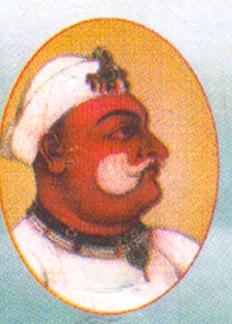
Maharaja Baldeo Singh, who succeeded Randhir Singh on the 8th October 1823, was anxious from tho very, beginning to secure the succession of his minor son Balwant Singh aged six years, as on one hand he anticipated his own death from the infirmities of an advanced age and on the other apprehended that Durjan Sal and Madho Singh the turbulent sons of his younger brother Lachhman Singh, who had claimed succession on Randhir Singh's death, wore sure to take advantage of Balwant Singh's minority and to dispute his succession.
Madho Singh, however, too impatient in his designs, invaded Jawahar Burj, the Mahamja's residence during his lifetime. Though he was arrested and imprisoned, yet Baldeo Singh's fears were confirmed and he invited General Ochterlony the Resident at Delhi to Bharatpur and implored for the public recognition by the British Government of the rightful heirship of his helpless child. This was granted and in the beginning of 1825 the young prince was invested by Sir David Ochterlony with a dress of honour and acknowledged as heir-apparent.
Durjan Sal rebels
Page 42
Baldeo Singh died on the 26th February 1825 and immediately Durjan Sal, gaining over a part of the army, forcibly assumed the government of the state, imprisoned the young Maharaja, his mother Maharani Amrit Kanwarji and Dhau Gyasi Ram his guardian and murdered his maternal uncle Choudhri Ram Ratan. Madho Singh was released and joined his brother in the revolt.
Diwan Jawahar Lall, Foujdar Churaman and Jani Baij Nath the principal nobles were faithful to their rightful master, the last of them who was State Vakil complained to Sir Ochterlony, who with his characteristic spirit and energy at once ordered troops and battering train to move upon Bharatpur and issued a proclamation to the people of the country to rise in defence of their 1awful ruler.
These troops would have easily cut the matters short, for, majority of the people was firm in their allegiance and would have co-operated with them, But the Governor-General, Lord Amherst unwilling to undertake another campaign when the attention and resources of the Government were demanded by the war in Barma, peremptorily disapproved Sir David's proceedings, ordered to recall the troops and withdraw the proclamation, only directing to institute an inquiry into the matter.
The veteran Ochterlony who was too high minded a soldier to undo what he had conscientiously done, tendered his resignation, retired to Merath and there died of broken heart;j while, even most of the faithful people of Bharatpur finding Durjan Sal's usurpation tolerated joined the rebellion. Besides the countrymen of Bharatpur,Agra and Mathur
Page 43
whom Durjan Sal called, the cry of war attracted a considerable body of Mahahtas, Rajputs and Sikhs, and the rebel was supported by the Maharaja of Karauli," who owed fealty to Bharatpur and probably expected to be relieved of the debt of the British Government on Bharatpur's account.
Soon after a quarrel broke out between Durjan Sal and Madho Singh, the latter took possession of Dig, plundered the country and defeated Durjan Sal's troops sent against him with great slaughter. The Company's frontiers were thrown into ferment, many of their subjects joined either party and the regions which had been pacified by the happy termination of the Marhata and Pindari wars were again threatened with anarchy.
Convinced by the arguments contained in an admirable state paper drawn by sir Charles Mettcalfe, successor to Sir David Ochterlony, that the British Government was bound to maintain the succession of Balwant Singh, in virtue of his previous investiture, as well as in in its general capacity of supreme guardian of right and tranquility, the Governor General was compelled to adopt the measures originally taken by Sir David Ochterlony; and a vast force exceeding 20,000 men with 100 pieces of artillery advanced upon Bharatpur under Lord Combermere the Commander-in-Chief. Durjan Sal was too proud to come to a term which could not be short of restoration of Balwant Singh to State, he even rejected the human offer of Lord Combermere to let his women and children pass safely through his camp. The raja of Nimrana attempted to cut the Moti, Jhil Band to fill the around the town, as it had been done in Lord Lake's siege in
Page 44
1805, but the English troops with the wisdom of the lesson learnt in that siege, coming in time, slew the Raja and stopped the Band.
Bharatpur was once again besieged on the 23rd December 1825, but the heavy batteries opened from the north-east out of Gopalgarh made no impression on the tough mud wall 50 feet thick the most impenetrable of all possible defences. Recourse was then had to mining operations, three mines were exploded on the night of the 17th January 1826, the most important of them containing 10,000 lbs. of gun-powder. The explosion was sublime, the whole of the salient angle and part of the stone cavalier named Nalwali Burj were hurled into the air, and men of the garrison blown up were buried amidst the ruins. The storming columns under Generals Nicolls and Renell rushed on to the assault with admirable spirit and in excellent order, ascended the breaches and cleared them in the teeth of a determined resistance. There was a mighty massacre and its result a brilliant victory. Within two hours the ramparts of the town were in possession of the besiegers who rushed in from all entrances. The gates of the citadel surrendered early in the afternoon and the victorious army was in undisputed command of it before the dusk of the evening on the 18th January 1826.
Durjan Sal, accompanied with one of his wives and two of his sons and followed by 160 chosen horse, forced his passage through the Kumher gate with a view of escaping to Bayana, but was made prisoner in the Ghana (forest) adjoining city, by the 8th Light Dragoons under Brigadier-General Sleigh. Jagat Singh his eldest son succeeded in reaching Bayana but he was also arrested there. They were all presented before Lord
Page 45
Combermere and sent as State prisoner to Allahabad and thence to Benares where his off springs still continue to reside.
Next morning Lord Combermere, Sir Charles Metcalfe, Mr. William Fraser and other British Officers repaired to the palace, and His Lordship taking the Maharaja in his lap, they all expressed their deep sympathy for his sufferings and made arrangements for his living with ease and comfort. On the 5th February 1826 they held a public Darbar in the palace and formally established the Maharaja in succession to his father, the administration of the state was vested in a Regency Council headed by Political Agent who in the first instance was Major Locket.
The entire loss of the British army was, 103 killed and 466 wounded and the loss of the rebels was estimated at 4000, nearly all killed by the awful explosion. The number of ordnance captured was 135, of which 12 were purchased by Jani Baij Nath for the use of the State and a very heavy gun is exhibited on a high platform in Fort Villiam Calcutta, as souvenir of this victory. The charges of the war being fixed at Rs. 25,49,000 against the State, Lord Combermere broke his camp on the 20th February and prize money amounting to £ 4,51,100 being granted by the king, was ordered by the Court of Directors to be distributed among the army. The Karauli Raja made humble professions of submission for supporting Durjan Sal in his rebellion and the British Government graciously did not think it necessary to take serious notice of his conduct.
Maharaja Balwant Singh
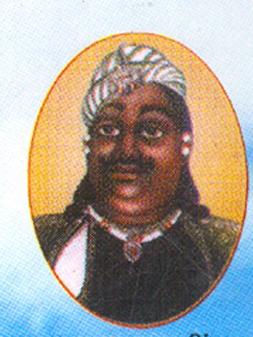
Maharaja Balwant Singh -In gratitude for being put in possession of his State, Balwant Singh always evinced a staunch fidelitty to the British Government ;made all European
Page 46
Officers in the neighbouring districts of Mathura and Agra his intimate friends and treated every Englishman who happened to be at Bharatpur as his welcome guest. On the visit of Lord Amherst to Agra in 1827, he sent Diwan Jawahar Lall and Foujdar Churaman on deputation and when His Lordship came to Bharatpur he received him at Bahnera and entertained him with great hospitality. He was among the princes who attended Lord Ellenborough's Darbar held at Delhi in 1842.
Jawahar Lal and after him his son Bhola Nath were tho Diwans of the state to 1840. The former to his death in 1830 conducted the affairs for 25 years and his thorough knowledge of revenue matters with rare combination of temper, patience and forbearance enabled him to carry on the work in a manner most beneficial to the state. Bhola Nath With an experience of his father's, lifetime, managed the affairs so well that it was difficult to point out a State better governed during that period than Bharatpur. In appreciation of the good administration the British Government in 1839 excused the State from the payment of the accumulated, arrears of interest on the unliquidated war charges incurred in 1826.
In 1835 Balwant Singh was invested with the powers of governing the State, the Political Agency was withdrawn, and Bharatpur remained directly under the Rajputana Agency.
Bhola Nath's party which consisted of almost all civil officers gaining much influence incurred the displeasure of the Maharaja, were, in 1840, put in confinement and a heavy fine was imposed upon them. They were, however, treated leniently and always considered as servants of the State, so that
Page 47
after Balwant Singh's death and during the minority of his son Jaswant Singh, Bhola Nath was again appointed a member of the Council and Adawlti (Magistrate and Judge) of Bharatpur and the value of the rations allowed during his confinement, Rs. 500 per month, was considered his sufficient pay for the future.
After the dismissal of Bhola Nath, the Maharaja personally conducted the state affairs in a simple but just and thorough working manner. No records of cases were prepared, but every complainant having an easy access to the prince was readily redressed.
The birth of his son Jaswant Singh in 1850, was celebrated by Balwant Singh with much liberality; lakhs of rupees were spent in gifts, feasts and entertainments given to the public for many months continually. Only three years subsequently Maharaja Balwant Singh breathed his last, leaving his son in childhood under the care of the British Government.
Maharaja Jaswant Singh
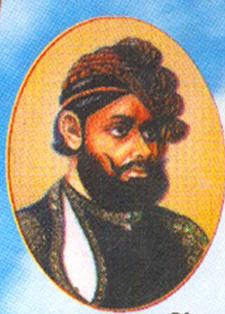
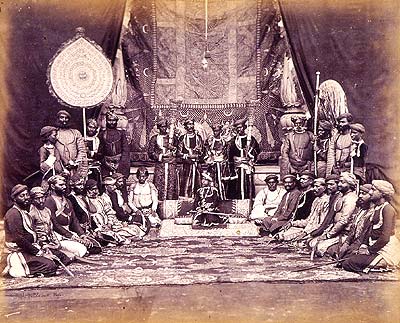
Maharaja Jaswant Singh - The first British officer that came to sympathize with Jaswant Singh on his being left an orphan, was Mr. Taylor, the Commissioner of Agra, an affectionate friend of the late Maharaja, who being disappointed in his desire to see him in his last sickness for which he had come, put the administration on a satisfactory footing by selecting Dhau Gyuii Ram as regent; the selection was confirmed by Major Morrison on his appointment as Political agent.
For two years the affairs went on in their former way; in 1855 Sir Henry Lawrence, the Agent Governor General, on his visit, to Bharatpur, appointed courts of justice at Bharatpur
Page 48
and Dig and started revenue settlement under Captain J.P. Nixon as Superintendent and Lieutenant Hamilton surveyor. Bharatpur is the first among the Rajputana States that has been blessed with the benefits of a revenue Settlement and that On a scientific basis, Major Morrison supervised the whole administration and watched the progress of the young Maharaja with particular care and affection.
During the mutiny of 1857, Bharatpur faithfully rendered good service to the British Government, a large body of troops of all arms went on field under Captain Nixon, one of the regiments having preserved peace in the Mathura district throughout the troublous period; three hundred sawars served for a long time under the Lieutt. Governor at Agra, parties of mutineers which entered the state or passed on its border, were attacked and such of them as could he arrested were made over to the British authorities, and a strong body of Bharatpur troops under Bakhshi Ganga Ram fought with Captain Nixon against mutineers led by Tantia Topi at Deosa in Jaipur and put them to flight.

In 1862, the Maharaja received the Sanad granting the privilege of adoption under the signature of Lord Canning the Viceroy and Governor General.
In 1863 the Regency Council agreed to cede lands required for Railway purposes free of cost, to compensate the owners of the lands, to make over to the British Government full jurisdiction short of sovereignty right in the lands and to abolish all traxisit duty on goods passing through by Railway. Lands were similarly ceded by the other States, Jaipur, Alwar, Jodhpur, Udaipur, and Tonk; it was only in the cases of Kishangarh and Sirohi that with regard to their limited income and
Page 49
consequent poverty, a compensation of Rs. 20,000 per Annam was allowed to Kishangarh and Rs. 10,000 to Sirohi.
In 1868 the Extradition treaty for the mutual surrender of offenders of certain specified charges was concluded between the British Government and the Bharatpur State; this treaty was modified in 1887 by a supplementary agreement providing that in the case of extradition of offenders from British India to Bharatpur the procedure for the time being in force in British India should in future be followed.
The Maharaja coming to mature age on the 10th January 1869, Captain Walter who had been Political Agent for a long time, made over the administration to His Highness, subject to his observance of 26 rules framed for his guidance. These rules were to last to the 28th March 1872, but Captain Cadel who was Political Agent in 1870, being satisfied that the Maharaja worked excellently, reported in July that they were quite unnecessary, Under the sanction of Government of India, Col. J. C. Brooke, the Agent Governor General came to Bharatpur and invested the Maharaja on the 7th March 1871 with a khilat and full governing powers of the State.
In his report on the high proficiency attained by Maharaja Jaswant Singh, Captain Walter had shown the necessity of an " Eton in India" for the education of the young princes; the proposal was approved and the establishment of the Mayo College was decided upon. The Maharaja liberally contributed Rs, 50,000, which was exceeded only by the subscriptions of Jaipur, Jodhpur, Udaipur and Kota and equaled by that of Bikaner; the other States subscribed smaller sums according to the means of each.
Page 50
Long before taking up the administration, the Maharnja had been trained in business and the experience he had gained under the friendly guidance of Captain Walter qualified him to conduct the affairs very creditably. For a few year; his court the Ijlas Khas was held at the palace in the fort and Bakhshi Sanwal Singh assisted him by disposing of the ordinary part of the work before his coming which he did with strict punctuality at 2 p. m. But subsequently he removed the office to his residence at Sewar and thenceforth managed tho State single handedly in a very efficient and excellent manner.
He was firm and very careful in his allegiance to the Imperial Government. In November 1869 when His Royal Highness the Duke of Edinborough came on a visit to India, he was one of the few Rajputana princes who joined the reception of His Royal Highness on his landing in Calcutta; and on His Royal Highness' proceeding to the up-country invited and entertained him with utmost hospitality at Bharatpur and Dig in 1870.
On the advent to Delhi of His late Gracious Majesty Emperor Edward VII (while Prince of Wales) in his tour of India in 1875-76, the Maharaja went to Delhi, partook in the camp of exercise and review of troops, in which he took a special interest, and going directly to Agra formally paid his homage to and was favoured with a return visit by His late Majesty. At his particular request His Majesty was graciously pleased to honour Bharatpur with his presence, once for duck-shooting in the forest locally called "Ghana" and again as the Maharaja's guest at the palace on his way to Jaipur.
Page 51
On numerous occasions he visited the Viceroys at Calcutta and Simla and the Agents to the Governor General at Ajmer and Abu; splendid receptions were given to the Viceroys and all high Officers at Bharatpur and Dig; and every European Officer visiting Bharatpur was treated as welcome guest.
He attended the Imperial Assemblage held at Delhi on the 1st January 1877 and in recognition of his sense of duty and excellent administration was invested with the insignia of a Knight Grand Commander of Star of India.
Jaswant Singh was anxious to have the Political Agency withdrawn from his capital, as it has been on his father's being entrusted with administration. Being satisfied that he was actuated to desire the change not from any lack in his loyalty to the Imperial Government hut with the ambition of managing his State without the help of a Political Agent, the Government of India removed the Office to Agra where the Maharaja provided a splendid house for the residence and Office of the Political Agent.
The Bharatpur country, particularly its parganas Bharatpur, Kumher and Dig, annually produced about 15,00,000 maunds of salt, which besides affording subsistence to about 50,000 people, was a source of revenue of about Rs. 3,00,000 to the State and of about Rs. 50,00,000 to the Imperial Government. In 1879 when the Sambhar Lake had been taken by the Government from Jaipur and Jodhpur and the Customs Line extending along the border of British India had been abolished, the manufacture of salt in the Bharatpur State was suppressed under
Page 52
Agreement, dated 23rd January. The duties on salt, sugar and other saccharine produces, except local cesses such as octroi and chungi levied on those articles imported for consumption in towns of above 5000 population, were abolished., The Maharajah required no compensation for his loss, but the Imperial Government spontaneously allowed Rs. 1,50,000 cash and 1000 maunds of Sambhar salt per Annam to the State.
Agreements facilitating the arrest and surrender of criminals were entered into between the Bharatpur Darbar on one hand and those of Alwar, Karauli, Dholpur and Jaipur on the other in 1882-83 under the sanction of Government of India.
In 1884 the Bharatpur Darbar abolished all transit duties with the exception of those on liquor, opium and other intoxicating drugs throughout the State.
Five outlying villages of Alwar situated within Bharatpur border and five such villages of Bharatpur within Alwar border, in many of which dispute was frequent about irrigation from water of the Ruparel, were exchanged by the two States on the 1st August 1885 and the exchange was sanctioned by the Government of India on the 22nd January 1886.
During the viceroyalty of Lord Dufferin (1884 -1888) when the aggressive attitude of Russia towards the Amir of Afganistan necessitated the deputation of a Boundary Commission, war seemed imminent and the native princes came forward with liberal offers of assistance, Maharaja Jaswant Singh was the foremost to place at the service of the Government, a regiment of 800 Infantry and another of 600 cavalry out of his already
Page 53
well disciplined troops. These Imperial Service Contingents, as they are called, have since then undergone many changes, the Bharatpur Cavalry Regiment, for instance, has been changed into a transport corps of 300 carts, 600 mules and 502 men; but the troops originally organised by the other Rajputana States were as follow and only the Alwar Infantry exceeded a little that of Bharatpur and others were comparatively less :-
- Alwar, 600 Cavalry and 1060 Infantry.
- Jodhpur, 600 Cavalry.
- Bikaner, 500 Camel Corps.
- Jaipur, 1,000 ponies, with men ⅔ of the animals and 400 carts.
In 1887 the Maharaja sent to England, a deputation of his four select Sardars. Colonel Pandit Karta Kishan and others, to pay his homage to Her Most Gracious Majesty Queen Victoria Empress of India, on the occasion of Her first Jubilee.
In order to secure uniformity in revenue records and collect statistics useful in various ways, the Maharaja in 1886 ordered the appointment of Patwaries in Muafi or rent-free villages. All Muafidars obeyed the order but the Thakurs of Pathena, following the example of their neighbours, the Jaipur and Alwar Thakurs whose defiance of the lawful authority often passes with impunity, assumed a refractory conduct and obstinately refused to pay Dami or Patwaris wages. The object was explained, and they.
Page 54
were politely assured that nothing injurious to their interest was intended, yet they did not at all obey the order. When all means failed to bring them to sense of duty, the Maharaja who never tolerated insubordination, obtaining previous sanction of the Supreme Government sent troops to carry out his order. The Thakurs resisted, Pathena was stormed, about a hundred of their men were slain, others fled, the fort was dismantled and the village was confiscated. Many of the fugitives were subsequently arrested and sentenced to various terms of imprisonment.
Bharatpur's salute is of 17 guns, equal to that of Jaipur, Jodhpur, Tonk, Bikaner, Bundi, Kota and Karauli. In the case of the last, it was raised from 15 for Maharaja Madan Pal for his services during the mutiny of 1857 but as the rule of personal salutes had not till then come in force it continued for his successors also. Udaipur alone in Rajputana has a salute of 19 guns, most of the other States have 15 guns and some even less. For his able administration and loyalty to the Imperial Government Maharaja Jaswant Singh had his personal salute increased to 19 guns in 1890.
Maharaja Jaswant Singh was a strong, sagacious and energetic ruler. With the benefit of good education in English and Vernacular received under the fostering care of Major Morrison and Colonel Walter, he thoroughly understood the details of administration and dealt with every question competently and with perfect facility. Sober in his thought and patient in working he was never out of humour, and as his actions were always guided by deliberate consideration, seldom did his projects fail in success.
Page 55
Economy of time and rare punctuality in daily routine enabled him to discharge his onerous duties creditably. Invariably he got up at 3 a.m., was sure to he on the parade at day-break and never failed in attending his office at 2 p.m. The discipline of the army was his favourite pursuit and be improved it to a highest degree. The manly exercise he took by personally commanding the troops, was much conducive to his health and being naturally of a stout constitution he rarely suffered from any disease.
In transacting business he strictly adhered to the principle of never leaving a work for to-morrow. Whatever might be the amount, he was sure to finish it on the same day, as no time was allowed to intervene between passing and issuing orders, correspondence was drawn up and dispatched before the next morning. The judicial cases were heard in presence of all parties concerned and no decision was passed before carefully hearing what each individual had to say. He distributed an evenhanded justice and his decisions were, as a rule, just and equitable.
Perfectly simple in his manners he required similar simplicity from all around him, and for nothing he had more decided aversion than to an arrogant pretension or to a feigned personal delicacy. Everyone had a free access to him but he was not credulous to an interested story, a remotest allusion to which was instantly detected by his keen intellect.
His knowledge of the state and its people was unusually extensive and knowing as many of his subjects as a chief in his position cannot be expected to know, he readily formed an appropriate opinion concerning their personal characters.
Page 56
Considerate in conversation he addressed everyone in polite terms; harsh words and abusive language were foreign to his nature; he was never in an angry or agitated state of mind, even in delivering a most severe sentence he took care not to provoke anyone's feelings.
Firm in his principles he in invariably observed the religious rites and family customs and each of his visits to Calcutta was accompanied by it pilgrimage to Jagannath. He took opportunities to visit Nathdwara, Hardwar and Pushkar, and built a temple of Brajendr Bihari at Sewar and regularly attended the service in it.
After a successful rule of 22 years and in the 42 year of his age Maharaja Jaswant Singh breathed his last on the 12th December 1893 and was succeeded by his son Ram Singh born on the 9th September 1872.
Maharaja Ram Singh
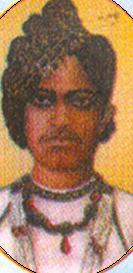
Maharaja Ram Singh happening to fall in bad association from the beginning was led to such intemperance and irregularities, as in a short period of one and a half year necessitated his being relieved of the charge of the state and himself, for the sake of his health, being placed under the care of Surgeon Major H. E. Drake Brockman. For sometime he made much progress in both physically and morally and it was expected he would regain his governing powers; but while on a visit to Abu in June 1900, he shot down one of his servants and was, therefore deposed and succeeded by his infant son Maharaja Kishan Singh, on the 26th August 1900.
Maharaja Kishan Singh
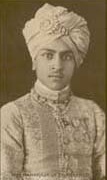
His Highness Sri Maharaja Brajendr Sawai Kishan Singh, Bahadur, Bahadur Jung. His Highness who was born on the 4th October 1899, is an active and intelligent young prince
Page 57
and a promising student of the Ajmer Mayo College. He is yet in his fourteenth year, but the good deeds he has done in his early life and which scarcely any prince of his position and age may have done, hold out strong hopes of his bright and brilliant future.
On Tuesday, the 27th February 1906, when only seven years old he had the honour to pay his respect at Agra to Her Gracious Majesty the Queen Empress (then Princess of Wales) on her Indian tour of 1905-6.
He went on a voyage to England in 1910 and rendered obeisance to His late Majesty Emperor Edward VII of blessed memory and when the heart-rending event of His Majesty's demise occurred he joined the funeral procession on the 14th May and represented the Indian aristocracy under the care of Sir Dunlop Smith in St. George's Chapel at the interment of His late Majesty on the 22nd May. On the 13th June 1910 His Gracious Majesty Emperor George V very kindly received him at the Marlborough palace.
His Highness took an important part in the recent Coronation Darbar held by His Gracious Majesty the King-Emperor at Delhi. Being appointed a page to attend upon Their Imperial Majesties in the Darbar ceremonials, he went to Delhi on tho 20th November 1911, met the Darbar Committee and learnt all that he had to do in that capacity. To his great credit he discharged his duties thoroughly and efficiently when the occasion required.
He was among the principal Rajputana ruling chiefs on the representation to the reception by His Majesty the King-Emperor
Page 58
Emperor, in the pavilion in the fort before the state entry and in His Majesty's camp in the afternoon on the 7th December 1911.
In the list of ruling chiefs of India arranged, according to the order of salutes, in the "Imperial Coronation Darbar Illustrated," published by the imperial publishing Company (Koshla Brothers) Bharatpur stands at No 16, out of 71, only Udaipur, Jaipur and Bikaner from Rajputana, being above it.
Along with his equally vigilant colleague Sumer Singh the Maharaja of Jodhpur, Maharaja Kishan Singh cut a prominent figure in the picturesque group of young princes that lined the steps on Their Imperial Majesty's proceeding to the throne in the Darbar Shamiana on the 12th December and supported the purple and white coronation robes of His Majesty, and the train of Her Majesty. Similarly he followed Their Imperial Majesties in their investiture procession on the 14th December.
His swiftness and alacrity were particularly displayed when leaving his place amongst the pages on the dais he advanced to the front of the throne, looked a charming veritable prince in shining garments broidered with gold, duly paid his homage to Their Imperial Majesties and moved backwards without, the least tottering in his steps.
Likewise he had a very enthusiastic reception in the review on the 4th December when in his brilliant uniform and riding on his beautiful horse with golden saddle cloth and trappings, he led his Imperial Service Infantry, "the Maharaj Paltan," past with steady and proportionate pace.
Page 59
Maharaja Kishan Singh whose education and training may, under the blessings of Almighty Providence and patronage of Their Gracious Majesties continue with perfect care, is to prove a model prince of India, a benevolent ruler to his subjects and a devoted feudatory to the Imperial Government.
- Note - Images are not part of the Original book but provided from Jatland Gallery to make content interesting.
Back to History of Bharatpur
Go to Appendix

